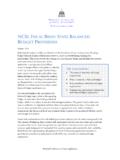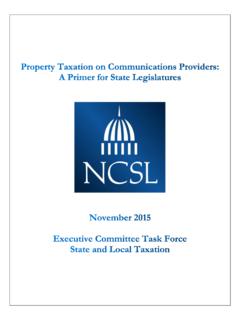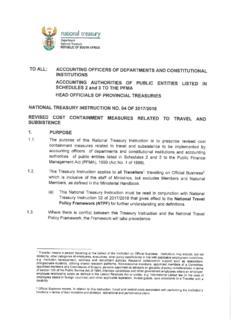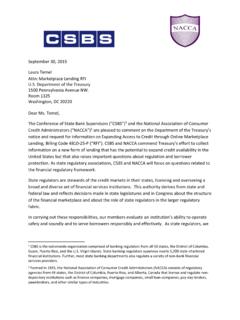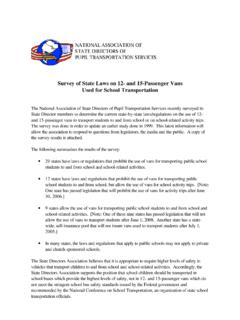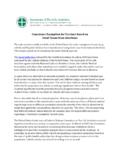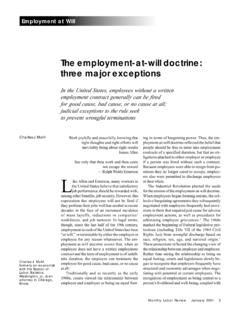Transcription of This PDF is a selection from an out-of-print volume …
1 This PDF is a selection from an out-of-print volume from the NationalBureau of Economic ResearchVolume Title: Public Finances: Needs, Sources, and UtilizationVolume Author/Editor: Universities- national Bureau Committee for Economic ResearchVolume Publisher: Princeton University PressVolume ISBN: 0-87014-303-4 volume URL: Date: 1961 Chapter Title: Practical Solutions to Financial Problems Created bythe Multilevel Political StructureChapter Author: I. M. Labovitz, L. L. Ecker-RaczChapter URL: pages in book: (p.)
2 135 - 228)Practical Solutions to Financial ProblemsCreated by the Multilevel Political StructureI. M. LABOVITZL. L. ECKER-RACZLIBRARY OF TREASURY1. IntroductionTms paper examines ways and means of increasing the financialcapabilities of state governments through adjustments in federal-state-local fiscal relations. Federalism, to be sure, creates problems at thefederal level as well, but these do not relate primarily to fiscal capa-bility. In a sense our primary concern is for the financial capabilitiesof local governments, since much of the initial impact of risingcivilian governmental costs is on them.
3 However, cities, counties,towns and school districts are the wards of the states and theirproblems the states' the last five years for which official data are available,1953 57, state and local "general government" absorbed nearly $200billion for direct general expenditures, capital outlay for local utilities,debt redemption, employee-retirement systems and increases in fundbalances (Table 1).To finance these expenditures, state and local governments raised$149 billion from their own revenue sources from taxes, fines, feesand licenses, interest earnings and the operation of utility and otherbusiness enterprises.
4 This left a gap of about $49 billion, bridged byfinancial aid from the federal government (about $16 billion) andand by borrowing (about $33 billion).This gap about $10 billion per annum is one quantitativeapproximation of the fiscal problem of state and local governmentswith which we are here concerned and for which solutions aresought. It is, however, little more than an approximation of magnitudes cited measure state and local performance theamounts spent and not the amounts that would have been spent ifadequate resources had been available to finance a level of govern-mental service consistent with need.
5 No measure is available of theNote. This paper does not necessarily reflect the views of the above CREATED BY MULTILEVEL POLITICAL STRUCTURETABLE1 Stateand Local "General Government" Operations, 1953 57 Use of funds:In millionsDirect general expenditure$169,484 Capital outlay for local government utilities5,146 Debt redemption12,037 Contribution to employee retirement systems5,1168 Increase in cash and security holdings (exclusive ofinsurance trust funds)7,095 Total (net of duplication)$198,003bSourceof funds.
6 General revenue from own sources$144,229 Net current surplus of utilities and liquor stores4,4Q7cIntergovernmental revenue from Federal Government16,140 Borrowing33,057 Total$197,833 SOURCE: Bureau of the Census, Governments subtracting from the total increase ($6,427 million) in retirement fundassets, the excess ($1,311 million) of their receipts, from employee contributions andinvestment earnings over their payments of benefits and the sum of detail by $875 million, representing employer contributionsby local governments to state administered employee retirement systems, includedabove in both "Direct general expenditure" and "Contributions to employee retirementsystems.
7 "CTheexcess of aggregate utility revenues over expenditures for utility operations andutility to which state and local performance fell short of need, apartfrom such fragmentary information as classroom shortages, deficientinstruction programs, substandard health and recreation facilities, , the magnitudes cited pertain to the past. They have beenincreasing and will continue to increase. During these five years alone,the size of the annual gap as here defined, , the amounts borrowedand obtained as federal aid, increased from $ billion to over $10billion.
8 The projections presented to this conference and other fore-casts suggest continuing increases in future magnitudes shown in Table 1 understate the problem alsobecause they are global for the country as a whole, and concealsubstantial deviations from the average in individual the upgrading of the less productive sections of the country,economic inequality continues to characterize the states and 'thepolitical subdivisions within individual states. As subsequent discus-sion indicates, this uneven geographic distribution of resources is thegenesis of many problems in federal-state fiscal posing the problem in terms of state-local financial require-ments, there is no intention to suggest that it exclusively or primarily136 PROBLEMS CREATED BY MULTILEVEL POLITICAL STRUCTURE concerns only state and local governments.
9 Problems at the statelevel quickly become matters for national and federal preoccupation with the inadequacy of the states' publiceducation systems provides a timely illustration, but one no moredramatic than national concern in earlier years with the inabilityof state governments to cope adequately with unemployment or theinadequacy of their resources for the payment of unemploymentbenefits during the 1957-58 recession. Neither is it our intention tosuggest that the problem of federalism is primarily one of dollarsand cents.
10 The philosophical values involved are indeed importantand their implications for the functioning of the political institutions for democratic government itself It is, however, infinancial terms that the problem of intergovernmental relations isgenerally presented. It is in financial terms that it will be or two additional stipulations. Intergovernmental problemsin a federalism do not admit of absolute solutions. A system ofgovernment wherein the severalstates with unequal economicresources undertake to conduct many of their affairs as one nationwhile retaining an important measure of sovereignty with respect tolarge sectors of governmental activity, can never be free of some of these do not lend themselves to neat solutions, they dolend themselves to Such accommodation,moreover,is likely to involve the established tools of intergovernmental relation-ships, rather than new arrangements still uninvented.











